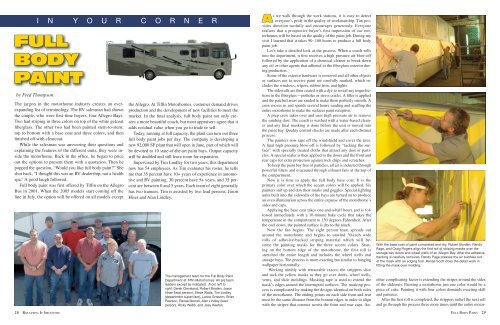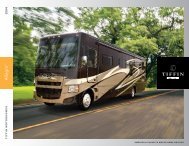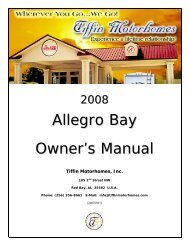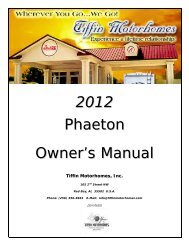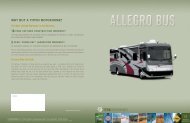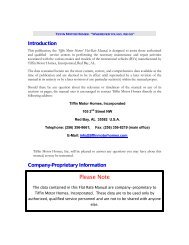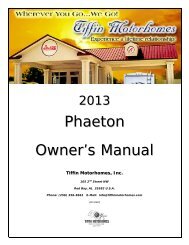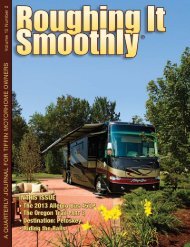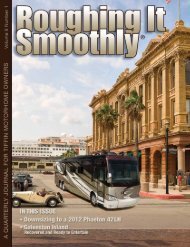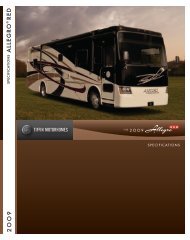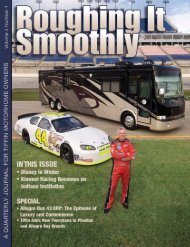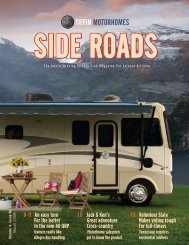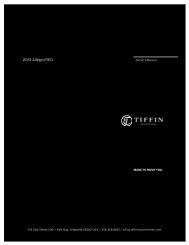I N Y O U R C O R N E RFULLBODYPAINTby Fred ThompsonThe jargon in the motorhome industry creates an everexpandinglist of terminology. The RV salesman had shownthe couple, who were first-time buyers, four Allegro Bays.Two had striping in three colors on top of the white gelcoatfiberglass. The other two had been painted stem-to-stern,top to bottom with a base coat and three colors, and thenfinished off with clearcoat.While the salesman was answering their questions andexplaining the features of the different units, they were insidethe motorhome. Back in the office, he began to priceout the options to present them with a quotation. Then hepopped the question, “Would you like full body paint?” Sheshot back, “I thought this was an RV dealership, not a healthspa.” A good laugh followed.Full body paint was first offered by <strong>Tiffin</strong> on the AllegroBus in 2001. When the 2005 models start coming off theline in July, the option will be offered on all models except28 ROUGHING IT SMOOTHLYthe Allegro. At <strong>Tiffin</strong> <strong>Motorhomes</strong>, customer demand drivesproduction and the development of new facilities to meet themarket. In the final analysis, full body paint not only createsa more beautiful coach, but most appraisers agree that itadds residual value when you go to trade or sell.Today, running at full capacity, the plant can turn out threefull body paint jobs per day. The company is developing anew 92,000 SF plant that will open in June, part of which willbe devoted to 10 state-of-the-art paint bays. Output capacitywill be doubled and still leave room for expansion.Supervised by Tim Lindley for two years, this departmentnow has 54 employees. As Tim evaluates his roster, he tellsme that 35 percent have 10+ years of experience in automotiveand RV painting, 30 percent have 5+ years, and 35 percentare between 0 and 5 years. Each team of eight generallyhas two trainees. Tim is assisted by two lead persons, JasonHiser and Alan Lindley.The management team for the Full Body PaintDepartment at <strong>Tiffin</strong> <strong>Motorhomes</strong>. All are teamleaders except as indicated. From left toright: Derek Cleveland, Robert Borden, JasonHiser (lead person), Steve Watts, Tim Lindley(department supervisor), Lance Grissom, BrianPearson, Ranae Morrell, Alan Lindley (leadperson), Ricky Webb, and Joey Keeton.As we walk through the work stations, it is easy to detecteveryone’s pride in the quality of workmanship. Tim providesdirection tactfully and encourages generously. Everyonerealizes that a prospective buyer’s first impression of our motorhomeswill be based on the quality of the paint job. During myvisit I learned that it takes 90–100 hours to produce a full bodypaint job.Let’s take a detailed look at the process. When a coach rollsinto the department, it first receives a high pressure air blow-offfollowed by the application of a chemical cleaner to break downany oil or other agents that adhered to the fiberglass exterior duringproduction.Some of the exterior hardware is removed and all other objectsor surfaces not to receive paint are carefully masked, which includesthe windows, wipers, rubber trim, and lights.The sidewalls are then coated with a dye to reveal any imperfectionsin the fiberglass—pinholes or stress cracks. A filler is appliedand the patched areas are sanded to make them perfectly smooth. Acrew moves in and spends several hours sanding and scuffing theentire motorhome to make the surfaces paint receptive.A prep crew takes over and uses high pressure air to removethe sanding dust. The coach is washed with a water-based cleanerand any final masking is done before the unit is moved intothe paint bay. Quality control checks are made after each distinctprocess.The painters now tape off the windshield and cover the tires.A final high pressure blow-off is followed by “tacking the surface”with specially treated cloths that attract any dust or particles.A special sealer is then applied to the doors and the front andrear caps for extra protection against rock chips and scratches.To keep the paint bay free of particles, all air is inducted throughpowerful filters and evacuated through exhaust fans at the top ofthe compartment.Now it is time to apply the full body base coat. <strong>It</strong> is theprimary color over which the accent colors will be applied. Sixpainters suit up and don their masks and goggles. Special lightingunits built into the sidewalls of the bays are turned on to producean even illumination across the entire expanse of the motorhome’ssides and caps.Applying the base coat takes one-and-a-half hours and is followedimmediately with a 10-minute bake cycle that takes thetemperature in the compartment to 130 degrees Fahrenheit. Afterthe cool down, the painted surface is dry to the touch.Now the fun begins. The eight person team spreads outaround the motorhome and begins to unwind 30-inch widerolls of adhesive-backed striping material which will becomethe painting masks for the three accent colors. Startingon the bottom edge of the motorhome, the first roll isstretched the entire length and includes the wheel wells andstorage bays. The process is more exacting but similar to hangingwallpaper horizontally.Working nimbly with retractable razors, the strippers sliceand tuck the yellow masks as they go over doors, wheel wells,vents, and slide moldings. Masking tape is used to extend themask’s edges around the interrupted surfaces. The masking processis complicated by making the designs identical on both sidesof the motorhome. The ending points on each side front and rearmust be the same distance from the bottom edges in order to alignwith the stripes that connect across the front and rear caps. An-With the base coat of paint completed and dry, Robert Borden, RandyPage, and Craig Rogers align the first roll of striping masks over thestorage bay doors and wheel wells of an Allegro Bay. After the adhesivebacking is carefully removed, Randy Page presses the air bubbles outof the mask with an edging tool. Renae Scott does the detail work infitting the mask over molding.other complicating factor is extending the stripes around the sidesof the slideouts. Painting a motorhome just one color would be apiece of cake. Painting it with four colors demands exacting skilland patience.After the first roll is completed, the strippers unfurl the next rolland go through the process three more times until the entire motor-FULL BODY PAINT 29
home is masked for painting. The entiremasking is completed in about two hours.The paint bay is cleaned again before thespraying begins for the three accent colors.After each color is applied, it is carefullycovered before the next application.The striping is removed revealing the basecoat again. The coach is now prepped forthe clearcoat which will enhance all of thecolors and give them a vivid appearance.Since the masking over the windows andhardware may have become saturated withpaint, remasking is done at this point to assurethat the clearcoat is applied only tothe painted surfaces. After another highpressure air blowoff, the area to be coatedis “tacked,” or wiped down with a specialchemically treated cloth.The six clearcoat painters put on suitsand breathing equipment that make onethink of the space program. In a one hourapplication they apply 3 – 3.5 mils of clearcoat.Once applied the coach goes througha 60-minute bake cycle that cures the paintand speeds the drying process.The designs are created by two companieswhich submit complete comprehensivesat least six months in advance ofthe model year change for each of thefive models produced by <strong>Tiffin</strong> <strong>Motorhomes</strong>.Several designs are presentedto Van <strong>Tiffin</strong> for each of the five <strong>Tiffin</strong>brands: Allegro, Allegro Bay, Phaeton,Allegro Bus, and Zephyr. Paint testing isdone in the plant for the colors recommendedby the design companies. Customer feedbackhelps determine the final selections.Quality control takes place at everystage during the two-day process of paintinga motorhome. <strong>It</strong> is imperative to removeany imperfections before the unitmoves to the next stage.With the painting process complete, thecoach moves to the reassembly bay to unmaskwindows, lights, wipers, reinstall anyexterior hardware, do minor buffing, andblack all of the door jams. Nearing the finalshipping point, the Quality Control Departmentdirected by Lex <strong>Tiffin</strong> moves into closely inspect the complete exterior ofthe coach. Under bright lights, trained eyessearch for any imperfections. The inspectorsmark with small strips of masking tapeany flaws they can find and the coach is returnedto the touch-up station for the minorrepairs. A couple of hours later a QCinspector returns to make sure the flawswere corrected.Robert Borden carefully positions the secondroll of masks to perfectly align with theintegrated design which has already beenapplied just below it.After one of the stripes has been painted in oneof the three accent colors, Brian Murray coversthe painted area with a paper mask to protectthe paint as the next accent color is applied byJohn Gordon.The painters wear white suits for their ownprotection and to avoid any minute particlesfrom flawing the clearcoat. The clearcoatproduces a sparkling gloss finish in all of thecolors.Anthony Searcy buffs the clearcoat finish tocreate a luster and add a final quality to the fullbody paint job.The options for every coach are specifiedby the actual buyer or a dealer. Eachunit now has its own unique personality asit is driven to Final Finish. At this stage ateam swarms over the motorhome to doa complete clean-up, inside and out. Twotechnicians slide back and forth on movableworkseats installing a clear rock guardacross the lower half of the front cap.After Final Finish, the QC techniciansfollow a checklist that takes them over everyinch of the coach before it is moved to thedelivery line in front of the main office.Tim Lindley knows everyone on his 54-person staff by first name. “From the firststep to the last, it takes 100 percent teamwork,”he emphasizes again. “Every phaseis critical. You can’t lower your concentrationat any stage for even a minute and getthe quality results that we demand fromourselves. <strong>It</strong> takes devoted people to turnout a good product.”The proof is in the pudding!A native of Red Bay, Tim Lindley completedhis eighth year last Decemberwith <strong>Tiffin</strong> <strong>Motorhomes</strong>. He and hiswife Barbara have two sons, Greg,19, and Chris, 14. Greg works in theelectrical department, making anotherof the many father-son combinationsat <strong>Tiffin</strong> <strong>Motorhomes</strong>. “One thingthat is really important to me workinghere,” he explained, “ is that we knowthat we have the full support from topmanagement to every supervisor, leadperson, and every employee in producingthe best quality product possible.That allows everybody to beproud of what they do.”A L L E G R O C L U B N E W SALLEGRO FAMILY LATESUMMER GETAWAYAmana Colonies RV ParkAmana, Iowa August 24–28, 2004by Jimmy Johnson, Club PresidentDon’t miss this late summer getawaywith your Allegro Family! <strong>It</strong>’s going to begreat fun and educational, too.Come along on Willkommen! Explorethe unique and fascinating history ofthe Amana Colonies, a National HistoricalLandmark, tucked among the rollinghills of eastern Iowa. “Gemutlichkeit” (inGerman indicating warmth, cheer, andfriendliness) overflows in the quaint sevenvillages founded about 150 years ago.Amana was inspired by the past. InGermany in the 1600s and 1700s, theLutheran clergy started the persecutionof the “True Inspirationists” because theyrefused to send their children to publicschools and they did not believe in performingmilitary duties.In 1842 Christian Metz and three followerstraveled to America to purchaseland for the community members. Theypurchased 5000 acres of land from theSeneca Indians near Buffalo, N.Y. In thebeginning it was hoped that the communitymembers could purchase their ownland, but they were unable to raise themoney.Metz proposed that a permanent constitutionbe adopted establishing a communalsystem. The system was adopted,and the community members shared thebusiness and property of Ebenezer, nearBuffalo. As time went by more land wasneeded to accommodate the 1200 communitymembers. Leaders looked to theWest where inexpensive farm land wasavailable. Four men were sent to checkout farm lands in Kansas and Iowa.They found what they were looking for inIowa.In 1855 Metz and his followers cameto Iowa and built a village. The villagewas called “Blaib Treu” or “Remain Faithful”.The leaders chose the name Amanafrom the Song of Solomon 4:8, where“Amana” means to “remain true.”Five more villages were built: MiddleAmana, High Amana, West Amana,South Amana, and East Amana. Withthe purchase of Homestead (the seventhvillage) in 1861 the community came toown 26,000 acres of land.Farming was the principle means oflivelihood. To meet the needs of the communityand to produce goods for sale tooutside markets, a calico works and twowoolen mills were established as well asa grist and flour mill. Brick and lumberfacilities were built. Basket-makers, bakers,tinsmiths, and other crafts peoplesupplied a variety of goods needed bythe community.Mothers of children under three yearsold stayed home with the youngsters.Preschool age children attended a“kinderschule” while their mothersworked. The older children attendedschool year-round.Members of the community attendedGerman-language church services orprayer meetings eleven times a week.As time went by, the economic pressuresand some dissatisfaction with thecommunal system arose in 1932. Amana,a profit sharing joint stock corporation,was established. This was knownas “the great change” which ended 89years of communal living. For the firsttime the community members ownedtheir own homes, worked for wages, orbecame proprietors of businesses. Newbusinesses were established includingAmana Refrigeration. Today the AmanaSociety farms the land and manages avariety of businesses.As you can see, the Amana Colonieshistorical enterprise is a treasure to Iowaas well as to its visitors. You will enjoythis collection of distinctive villages, aNational Historic Landmark. You are infor a unique experience seeing the artisansand craftsmen at work. The AmanaColonies were built on tradition andquality by people who believe in hardwork and excellent craftsmanship. Don’tmiss this wonderful experience. See youin Amana!Allegro Family Late Summer RallyAmana Colonies RV ParkAmana, IowaAugust 24-29Motorhome with two people, $452.69Motorhome with one person, $351.47Each guest in member’s motorhome,$99.37To join the Allegro Club, call256-356-8522Six men’s teams and two women’s teams competed in the Allegro Family Annual Winter GolfRally in Magnolia Springs, Alabama, Feb. 15–21. The competition was followed each evening withdelicious meals in area restaurants.30 ROUGHING IT SMOOTHLY31


